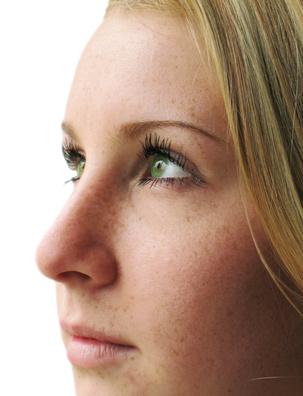Many women anticipate pregnancy as a time when their hair and nails grow at record pace and their skin practically glows. So it comes as quite a shock when they look in the mirror to see dark, blotchy brown spots reflected back at them. According to the American Congress of Obstetricians and Gynecologists, more than 90 percent of all pregnant women experience some skin discoloration.
Cause
Melasma, also called chloasma or “the mask of pregnancy” for the distinctive masklike appearance on the face, is a common skin condition that affects the majority of pregnant women. Doctors believe a surge of estrogen during pregnancy causes an overproduction of melanin. Melanin is the pigment in cells called melanocytes that give skin its color. The job of a melanocyte is to protect the skin from sun exposure, particularly ultraviolet light. The more sun a person is exposed to, the more pigment the melanocytes produce. As a result, people with darker complexions produce more melanin than people with lighter skin tones. During pregnancy, moles and freckles, which are concentrated areas of melanin, appear darker and more numerous. The good news is that the majority of pregnancy melasma fades within the first few months after delivery. New moles and freckles are likely permanent, though.
Location
The condition appears most notably across the forehead, cheeks, upper lip and the bridge of the nose. Doctors estimate that nearly 70 percent of pregnant women develop melasma on their face. However, melasma also develops on other areas of the body such as the breasts, inner thighs, forearms and neck. As the pregnancy progresses, many women notice a dark line on their abdomen that runs vertically from their navel to the pubic bone. This line is called the linea nigra and although it is always present, it is most noticeable during pregnancy.
Prevention and Treatment
Dr. Carol Bates, an assistant professor of medicine at Harvard Medical School who treats patients at Boston’s Beth Israel Deaconess Medical Center, suggests that women who are sexually active take a folic acid supplement. Folic acid protects developing embryos against neural tube defects, even long before a woman realizes she is pregnant. More superficially, folic acid also combats melasma and “the mask of pregnancy.” A diet rich in citrus fruits and leafy green vegetables is a healthy way for pregnant women to get the folic acid they need. The American Academy of Dermatology recommends applying sunscreen with a minimum SPF 30 to reduce the appearance of melasma. Also, wide-brim hats and protective clothing minimize overexposure to sun. Pregnant women can cover brown spots on their faces with concealing makeup. However, they should not use skin bleachers or chemical peels.
Photo Credit
- Face close-up image by Alice from Fotolia.com





